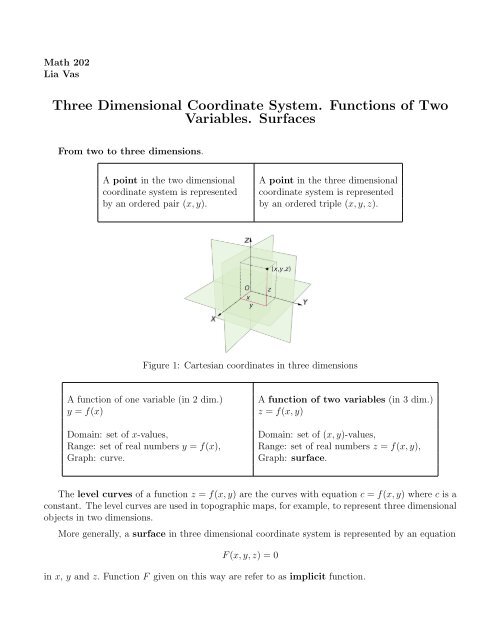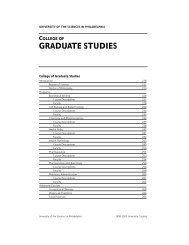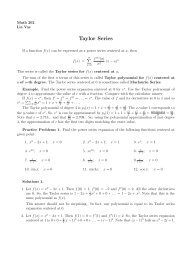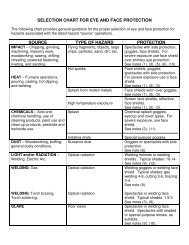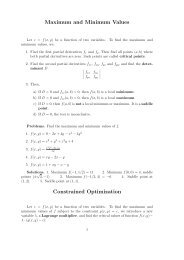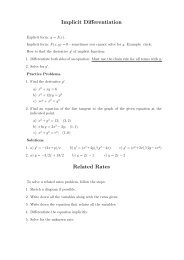Three Dimensional Coordinate System. Functions of Two Variables ...
Three Dimensional Coordinate System. Functions of Two Variables ...
Three Dimensional Coordinate System. Functions of Two Variables ...
You also want an ePaper? Increase the reach of your titles
YUMPU automatically turns print PDFs into web optimized ePapers that Google loves.
Math 202<br />
Lia Vas<br />
<strong>Three</strong> <strong>Dimensional</strong> <strong>Coordinate</strong> <strong>System</strong>. <strong>Functions</strong> <strong>of</strong> <strong>Two</strong><br />
<strong>Variables</strong>. Surfaces<br />
From two to three dimensions.<br />
A point in the two dimensional<br />
coordinate system is represented<br />
by an ordered pair (x, y).<br />
A point in the three dimensional<br />
coordinate system is represented<br />
by an ordered triple (x, y, z).<br />
Figure 1: Cartesian coordinates in three dimensions<br />
A function <strong>of</strong> one variable (in 2 dim.) A function <strong>of</strong> two variables (in 3 dim.)<br />
y = f(x) z = f(x, y)<br />
Domain: set <strong>of</strong> x-values,<br />
Range: set <strong>of</strong> real numbers y = f(x),<br />
Graph: curve.<br />
Domain: set <strong>of</strong> (x, y)-values,<br />
Range: set <strong>of</strong> real numbers z = f(x, y),<br />
Graph: surface.<br />
The level curves <strong>of</strong> a function z = f(x, y) are the curves with equation c = f(x, y) where c is a<br />
constant. The level curves are used in topographic maps, for example, to represent three dimensional<br />
objects in two dimensions.<br />
More generally, a surface in three dimensional coordinate system is represented by an equation<br />
F (x, y, z) = 0<br />
in x, y and z. Function F given on this way are refer to as implicit function.
If the equation F (x, y, z) = 0 can be solved for z, for example, the solution<br />
z = f(x, y)<br />
represent the explicit form <strong>of</strong> function F.<br />
Examples.<br />
1. Line in two dimensions Plane in three dimensions<br />
ax + by = c<br />
ax + by + cz = d<br />
2. Circle in two dimensions Sphere in three dimensions<br />
Center: (a, b), radius: r. Center: (a, b, c), radius: r.<br />
(x − a) 2 + (y − b) 2 = r 2 (x − a) 2 + (y − b) 2 + (z − c) 2 = r 2<br />
Figure 2: Sphere (x − a) 2 + (y − b) 2 + (z − c) 2 = r 2<br />
The formula for circle/sphere follows from the formula for the distance:<br />
The distance between the points The distance between the points<br />
P (x 1 , y 1 ) and Q(x 2 , y 2 ) P (x 1 , y 1 , z 1 ) and Q(x 2 , y 2 , z 2 )<br />
|P Q| =<br />
√<br />
√<br />
(x 1 − x 2 ) 2 + (y 1 − y 2 ) 2 |P Q| = (x 1 − x 2 ) 2 + (y 1 − y 2 ) 2 + (z 1 − z 2 ) 2<br />
The equation <strong>of</strong> this circle in three dimensions is obtained from the formula that describes all<br />
points (x, y, z) with the distance r from the point (a, b, c) :<br />
Distance =<br />
Examples (continued).<br />
√<br />
(x − a) 2 + (y − b) 2 + (z − c) 2 = r ⇒ (x − a) 2 + (y − b) 2 + (z − c) 2 = r 2 .<br />
3. Cylindrical surfaces – one variable not present in the equation. For example, z = f(y). To<br />
graph this surface, graph the function z = f(y) in yz-plane and translate the graph in direction<br />
<strong>of</strong> x-axis. For example,<br />
– The graph <strong>of</strong> x 2 + y 2 = 4 is the cylinder obtained by translating the circle x 2 + y 2 = 4<br />
<strong>of</strong> radius 2 centered at the origin in xy-plane along z-axis.
– The graph <strong>of</strong> y 2 + z 2 = 4 is the cylinder obtained by translating the circle y 2 + z 2 = 4 <strong>of</strong><br />
radius 2 centered at the origin in yz-plane along x-axis.<br />
Figure 3: Cylinder x 2 + y 2 = 4 Cylinder y 2 + z 2 = 4<br />
4. Surfaces <strong>of</strong> revolution: z = f( √ x 2 + y 2 ). To get graph <strong>of</strong> such surface, graph the function<br />
z = f(y) in yz-plane and let it rotate about z-axis. For example<br />
– The cone z = √ x 2 + y 2 is obtained by rotating the line z = y.<br />
– The paraboloid z = x 2 + y 2 is obtained by rotating the parabola z = y 2 .<br />
– The hemisphere z = √ 1 − x 2 − y 2 is obtained by rotating the half-circle z = √ 1 − y 2 .<br />
Figure 4: Cone Paraboloid Hemisphere<br />
Practice problems. (a) Identify and sketch the following points, surfaces or regions in three<br />
dimensional coordinate system.<br />
1. P (2, −1, 3) 2. Q(0, 2, 0)<br />
3. Sphere with center Q and radius 2. Find the equation <strong>of</strong> this sphere.<br />
4. Find the equation <strong>of</strong> the sphere that passes through the point P and has center at Q.<br />
5. z = 1 6. y = 2 7. y > 2<br />
8. x + y = 2 9. 2x + 3y + z = 6 10. x 2 + y 2 = 9<br />
11. x 2 + y 2 ≤ 9 12. x 2 + z 2 = 9 13. x 2 + y 2 + z 2 ≤ 4<br />
14. 1 ≤ x 2 + y 2 + z 2 ≤ 4 15. z = √ 9 − x 2 − y 2 16. z = 9 − x 2 − y 2<br />
17. z = 1<br />
x 2 +y 2 18. z = sin √ x 2 + y 2 19. z = y 2
(b) Find the domain <strong>of</strong> the following functions.<br />
1. z = 6 − 2x − 3y 2. z = √ 9 − x 2 − y 2 3. z = 1<br />
x 2 +y 2<br />
Solutions. (a) 1. Point in front upper left octant. 2. Point on positive part <strong>of</strong> y-axis.<br />
3. (x − 0) 2 + (y − 2) 2 + (z − 0) √<br />
2 = 2 2 ⇒ x 2 + (y − 2) 2 + z 2 = 4. 4. Center is (0,2,0) and<br />
the radius is the distance |P Q| = (2 − 0) 2 + (−1 − 2) 2 + (3 − 0) 2 = √ 4 + 9 + 9 = √ 22. So, the<br />
equation <strong>of</strong> the sphere is x 2 + (y − 2) 2 + z 2 = 22.<br />
5. Horizontal plane passes 1 on z-axis. 6. Vertical plane parallel to xz-plane, passing 2 on<br />
y-axis.<br />
7. Region on the right from plane y = 2. 8. Vertical plane (parallel with z-axis) passing the<br />
line x + y = 2 in xy-plane.<br />
9. Plane passing (3,0,0), (0,2,0), and (0,0,6) on the coordinate axis (to see this, put y = z = 0<br />
and get x = 3 so the plane passes (3,0,0); put x = z = 0 and get y = 2 so the plane passes (0,2,0);<br />
put x = y = 0 and get z = 6 so the plane passes (0,0,6)).<br />
10. Vertical cylinder (parallel with z-axis), passing the circle x 2 + y 2 = 9 in xy-plane.<br />
11. The cylinder from the previous problem together with its interior (the region inside <strong>of</strong> it).<br />
12. Horizontal cylinder (parallel with y-axis), passing the circle x 2 + z 2 = 9 in xz-plane.<br />
13. The interior <strong>of</strong> the sphere centered at the origin <strong>of</strong> radius 2.<br />
14. The region between the sphere <strong>of</strong> radius 1 centered at the origin and the sphere <strong>of</strong> radius 2<br />
centered at the origin. 15. Upper hemisphere centered at the origin <strong>of</strong> radius 3.<br />
16. Paraboloid obtained by rotating the parabola z = 9 − y 2 in yz-plane about the z-axis.<br />
17. The surface obtained by rotating the curve z = 1 in yz-plane about the z-axis.<br />
y 2<br />
18. The surface obtained by rotating the curve z = sin y in yz-plane about the z-axis.<br />
Figure 5: Surface z = sin √ x 2 + y 2<br />
19. The cylindrical surface obtained by translating the z = y 2 in yz-plane along the x-axis.<br />
(b) 1. All pairs (x, y). 2. All pairs (x, y) such that x 2 + y 2 ≤ 9 (i.e. the interior <strong>of</strong> the circle<br />
centered at origin <strong>of</strong> radius 3). 3. All pairs (x, y) except (0, 0).


